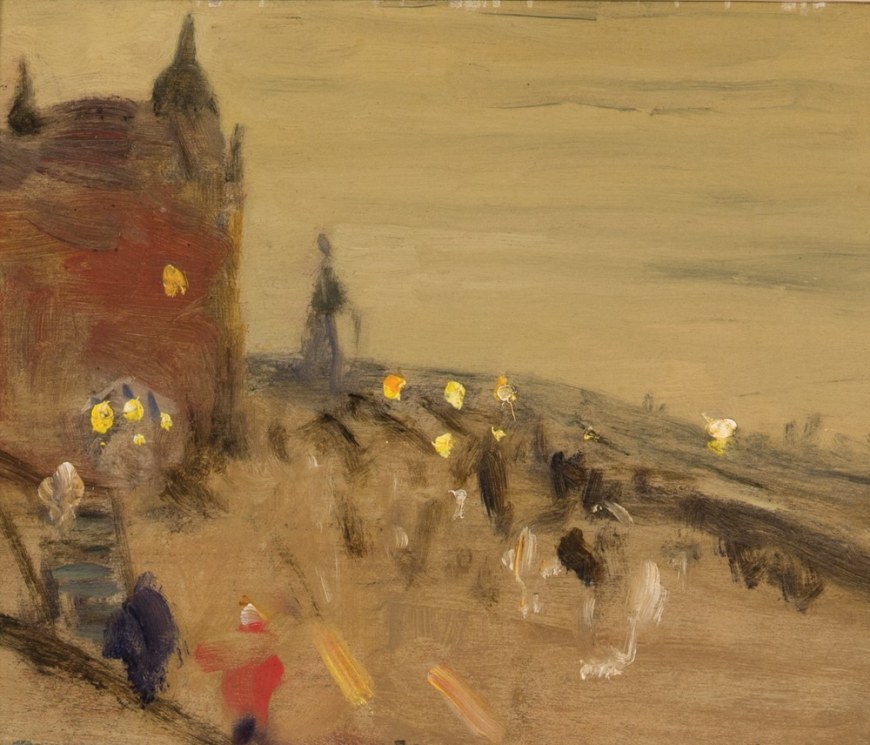-
Artworks
James Wilson MorriceTerrace, Château Frontenac, Quebec, 1910 (circa)1865-1924Oil on wood panel4 7/8 x 6 in
12.3 x 15.4 cmSoldInscriptions
inscribed ‘A.F. Nation / 250 (verso, centre)Provenance
Mrs Arthur F. Nation, née Madeleine Hope Hanson.
Christie, Manson & Woods (Montreal), 24 October, 1974.
The Collection of Mitzi and Mel Dobrin.
Exhibitions
Victoria B.C., Art Gallery of Greater Victoria, Ten Canadians, ten decades: an exhibition organized with the aid of a grant from the national Centennial Commission, 15 April - 14 May, 1967, no. 8 as Terrace, Quebec;
Montreal, Montreal Museum of Fine Arts, James Wilson Morrice 1865-1924, 6 Dec. 1985 - 2 Feb. 1986 (then touring), no. 24 as La Terrasse et le Château Frontenac, Québec / The Promenade, Chäteau Frontenac, Québec (ill.), presented in Montreal and Québec City only.
The title could be Impression, Dufferin Terrace, a fleeting moment captured at sunset. The Terrace, Québec City's outdoor salon, overlooks the basse-ville and the St. Lawrence river, with Lévis across, and Ile d'Orléans to the left. Morrice always stayed at the Château Frontenac when he visited, usually in winter, and he loved the view from its windows. But tonight, in the summer of 1910, the air is warm and inviting; after a good supper, he steps out of his hotel, his little sketchbox in his pocket, just in case. He has already sketched the view in daylight; these two sketches of the Terrace, plus a small portrait of William Brymner painted at Saint-Eustache near Montréal (Montreal Museum of Fine Arts), are the only works he brought back to Paris. From the daylight sketch, he will paint Terrace, Québec, the beautiful canvas first shown in Paris the next Spring, and last at the opening of the Alan Klinkhoff Gallery in Toronto (in 2014, now private collection).
No related sketchbook has yet been found. Unlike his previous two visits, in the winters of 1905-06 and 1908-09, Morrice was not here to work, but to rest and to celebrate his parents. The previous months were spent working in Concarneau, Brittany, with short visits to Paris. On the inside back cover of his current sketchbook (# 15, MMFA), we find a list of works sent to exhibitions in Paris and London that Spring, and some other notes; to the right, he wrote Golden Wedding / June 14. Steamer departure dates in early June were written down, but Morrice finally landed in New York on the 17th... missing the family gathering. He returned to Paris in early August; we don’t know what else he did that summer, besides what the three known sketches (including this one) tell us. And we are lucky to have them: his previous summer visit, in 1903, did not inspire him at all.
The view of the Terrace that Morrice painted looks almost the same today, especially at night – even if this portion of the Château was rebuilt, slightly differently, after a 1926 fire (the iconic tower, then a recent addition, was saved). To paint his pochade, Morrice positioned himself on the grass, near the row of cannons; the music kiosk – a strong presence in the day sketch and its canvas -- is here reduced to a few stripes and three bright lights, hardly recognizable; ditto for the steeple of the old Université Laval. At right, the evening sky blurs the distinction between sky, river and land. Because of this nocturne atmosphere, the sketch has previously been ascribed to a visit in the winter of 1896-97, when Morrice was still under the spell of James McNeill Whistler. But there is no snow here; more importantly, it is only around 1904-05 that the Canadian painter started to use a more rapid technique; by 1910 he had mastered it. In the day sketch of the Terrace and the Brymner portrait, both painted quickly with thin paint in bright daylight, the artist underlined some details with a fine pencil. But not here: he had to work very quickly, to take advantage of the last rays of the setting sun.
This beautiful pochade had only one owner before the Dobrin family, Mrs. Arthur F. Nation. As Madeleine Hope Hanson, she had befriended Suzor-Coté in her native Montreal, and apparently posed for him (around 1915). She followed her husband to Vancouver in 1934, and they retired in Victoria. Mr. Nation, his wife Madeleine and a daughter all served during World War 2, Madeleine ending her military career as a Major in the Canadian Women's Army Corps.
Lucie Dorais4of 4








